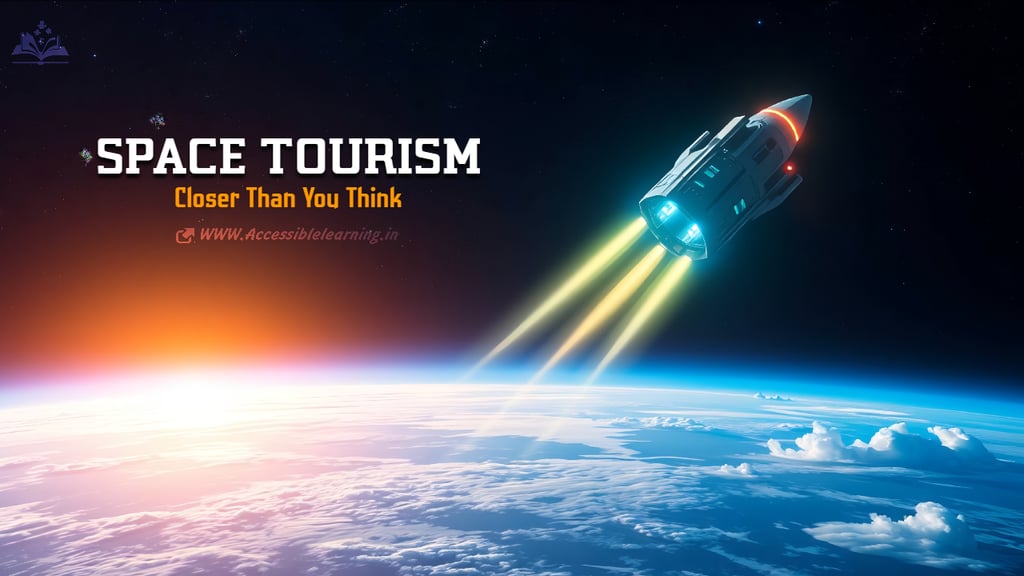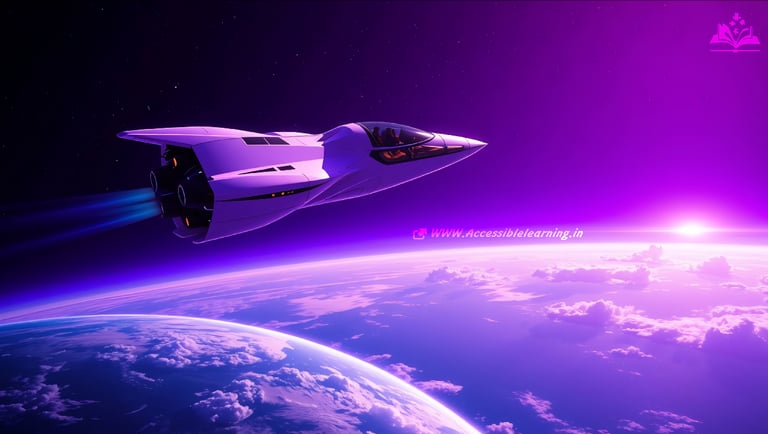
Why Space Tourism Might Be Closer Than You Think: The Dawn of Commercial Space Travel
Space tourism is accelerating toward mainstream accessibility, with Virgin Galactic, Blue Origin, and SpaceX leading commercial flights in 2025.
SPACE MISSIONTRAVEL LIFEISRO/NASASPACE/TECH
Sachin K Chaurasiya
8/14/20256 min read


Space tourism has evolved from science fiction fantasy to commercial reality faster than most experts predicted. With Virgin Galactic's maiden commercial space flight from Spaceport America in New Mexico carrying six paying customers in January 2025 and Blue Origin's 10th human flight lifting off on February 25, 2025, the space tourism industry is experiencing unprecedented momentum that suggests widespread accessibility may arrive sooner than anticipated.
The Current State of Space Tourism: From Dream to Reality
The commercial space travel landscape has transformed dramatically over the past decade. Three major players dominate the current market, each offering distinct experiences at varying price points and accessibility levels.
Suborbital Space Tourism Leaders
Virgin Galactic and Blue Origin have pioneered the suborbital space tourism market, focusing on brief but transformative journeys to the edge of space. Blue Origin and Virgin Galactic are providing cheaper suborbital trips, while SpaceX and Axiom are taking paying customers on orbital journeys. These suborbital flights reach altitudes above the Kármán line (100 kilometers above Earth), allowing passengers to experience weightlessness and view Earth's curvature during flights lasting several minutes.
Orbital Space Tourism Evolution
SpaceX has established itself as the leader in orbital space tourism, offering multi-day experiences aboard the International Space Station and private orbital missions. SpaceX continues to push the boundaries of commercial spaceflight with its Starship program, partnering with Axiom Space to provide private orbital missions and contribute to the development of commercial space stations.
Breaking Down Space Tourism Costs: Accessibility on the Horizon
Current pricing structures reveal the industry's trajectory toward broader accessibility, though costs remain substantial for most consumers.
Suborbital Flight Pricing
Virgin Galactic and Blue Origin charge prices from $250,000 to $1.3 million per ticket, with costs ranging from hundreds of thousands to millions of dollars. However, ticket prices are reportedly about $500,000 per passenger for suborbital flights, with experts believing costs will decrease with more frequent launches.
Orbital Mission Investment
Orbital space tourism requires significantly higher investment levels. Between 2020 and 2025, the going rate for private orbital missions has remained around $50 million per seat due to extensive training, higher risks, and the complex logistics of sending civilians into orbit. Chartering a SpaceX capsule into orbit costs around $200 million.

Industry Growth Projections: Accelerating Timeline to Mainstream Adoption
The space tourism sector is experiencing exponential growth across multiple dimensions, from technological advancement to market expansion.
Mission Frequency Scaling
Axiom Space is leading the next phase of commercial space exploration with its plan to send three private astronaut missions per year by 2026, laying the foundation for a fully commercialized low Earth orbit economy. Additionally, SpaceX is gearing up for a significant leap with a proposal to increase Starship test launches to 25 in 2025, a fivefold increase from the five demonstration launches scheduled for 2024.
Market Participation Growth
Over 120 civilians have entered space via SpaceX, Blue Origin, and Virgin Galactic, with ticket prices ranging from US$500,000 to US$2 billion. This growing participant base demonstrates increasing market confidence and operational reliability.
Technological Advancements Driving Accessibility
Several breakthrough technologies are accelerating the timeline for mainstream space tourism adoption.
Reusable Spacecraft Technology
Reusable rocket technology has fundamentally altered space travel economics. SpaceX's Falcon 9 and Falcon Heavy systems, along with Blue Origin's New Shepard, have demonstrated reliable reusability that significantly reduces per-flight costs. This technological foundation enables more frequent flights and operational efficiency improvements.
Advanced Safety Systems
Modern spacecraft incorporate multiple redundant safety systems, automated flight controls, and escape mechanisms that reduce training requirements and operational risks. These improvements make space tourism more accessible to civilians without extensive astronaut training backgrounds.
Manufacturing Scale Economies
As production volumes increase, spacecraft manufacturing costs decrease through economies of scale. Companies are transitioning from custom-built vessels to production-line approaches that will further reduce operational expenses.
Infrastructure Development: Building the Foundation for Mass Market Access
The space tourism industry is rapidly developing supporting infrastructure that will enable broader market participation.
Spaceport Expansion
Commercial spaceports are expanding beyond traditional government facilities. Spaceport America in New Mexico, Kennedy Space Center in Florida, and emerging facilities worldwide provide dedicated infrastructure for commercial space operations.
Training Facility Networks
Specialized training centers are developing standardized preparation programs that reduce time and cost requirements for space tourists. These facilities focus on essential safety procedures rather than extensive astronaut training protocols.
Supply Chain Maturation
The commercial space industry supply chain is maturing rapidly, creating cost efficiencies and reliability improvements that benefit space tourism operations.
Regulatory Environment: Streamlining Path to Commercial Operations
Government agencies worldwide are developing regulatory frameworks specifically designed to support commercial space tourism while maintaining safety standards.
FAA Commercial Space Transportation
The Federal Aviation Administration has established clear certification processes for commercial space vehicles and operations, providing regulatory certainty that enables business planning and investment.
International Coordination
International space agencies are coordinating standards and procedures to enable cross-border space tourism operations, expanding market opportunities and operational flexibility.


Market Demand Indicators: Consumer Interest Exceeds Current Capacity
Multiple indicators suggest consumer demand for space tourism experiences significantly exceeds current industry capacity.
Reservation Lists and Deposits
Virgin Galactic, Blue Origin, and other operators maintain substantial reservation lists with paying deposits, indicating strong market demand despite current pricing levels.
Corporate and Educational Markets
Beyond individual consumers, corporations are exploring space tourism for executive experiences, team building, and marketing initiatives. Educational institutions are developing space tourism programs for research and experiential learning.
Demographic Expansion
The target demographic for space tourism is expanding beyond ultra-high-net-worth individuals to include upper-middle-class consumers as pricing becomes more accessible.
Frequently Asked Questions
Q: How much will space tourism cost in the next five years?
Industry analysts project suborbital space tourism prices will decrease to $100,000-$200,000 per seat by 2030 as operational efficiency improves and competition increases. Orbital missions may be reduced to $10-20 million per seat for private missions.
Q: What training is required for space tourists?
Current suborbital flights require 2-3 days of basic safety training, while orbital missions require several weeks of preparation. Training requirements are decreasing as spacecraft automation improves and safety systems become more sophisticated.
Q: How safe is commercial space tourism?
Commercial space tourism has achieved strong safety records through extensive testing, redundant safety systems, and gradual operational scaling. While inherent risks exist, safety levels continue improving with experience and technological advancement.
Q: When will space tourism become mainstream?
Industry projections suggest space tourism will achieve mainstream accessibility (similar to luxury cruise pricing) within 10-15 years, driven by technological improvements, increased competition, and operational scaling.
Q: Which companies offer the most accessible space tourism options?
Virgin Galactic and Blue Origin currently offer the most accessible options for suborbital flights, while SpaceX provides orbital experiences. Emerging companies worldwide are developing additional options that may further increase accessibility.
Economic Impact: Space Tourism as Economic Driver
The space tourism industry generates significant economic benefits that extend beyond direct participants.
Job Creation & Economic Development
Space tourism operations create high-skilled employment opportunities in engineering, manufacturing, operations, and support services. Local economies around spaceports benefit from increased business activity and tourism.
Technology Transfer Benefits
Innovations developed for space tourism applications often transfer to other industries, creating broader economic value through improved manufacturing processes, materials science, and safety systems.
Investment Capital Flow
The space tourism sector attracts substantial private investment that funds research, development, and infrastructure improvements benefiting the entire commercial space industry.
Future Outlook: Timeline for Mainstream Adoption
Based on current trajectory analysis, space tourism accessibility will likely follow a predictable adoption curve.
2025-2027: Early Adopter Phase
Current pricing and capacity limitations will gradually improve, with suborbital flights becoming accessible to affluent consumers rather than only ultra-wealthy individuals.
2028-2032: Growth Phase
Technological improvements, increased competition, and operational scaling will drive significant price reductions and capacity increases, making space tourism accessible to upper-middle-class consumers.
2033-2040: Mainstream Phase
Mass production techniques, mature technology, and established infrastructure will enable space tourism pricing comparable to luxury travel experiences, achieving true mainstream accessibility.
Space tourism stands at a pivotal moment where technological capability, market demand, and economic incentives align to accelerate mainstream adoption. Space tourism is not far from becoming a new type of tourism thanks to technological advancements, private investment, and a growing interest in commercial space experiences.
The convergence of reusable spacecraft technology, expanding infrastructure, supportive regulatory environments, and strong market demand creates conditions for faster-than-expected mainstream adoption. While current pricing remains exclusive, the trajectory clearly points toward broader accessibility within the next decade.
For consumers interested in space tourism experiences, the timeline for accessibility continues accelerating. Industry developments in 2025 demonstrate that space tourism has moved beyond experimental phases into operational commercial reality, with continued improvements promising expanded access for adventure-seeking travelers worldwide.
The question is no longer whether space tourism will become mainstream, but rather how quickly technological and economic factors will make these extraordinary experiences accessible to ordinary travelers seeking the ultimate adventure beyond Earth's atmosphere.
Subscribe To Our Newsletter
All © Copyright reserved by Accessible-Learning Hub
| Terms & Conditions
Knowledge is power. Learn with Us. 📚


